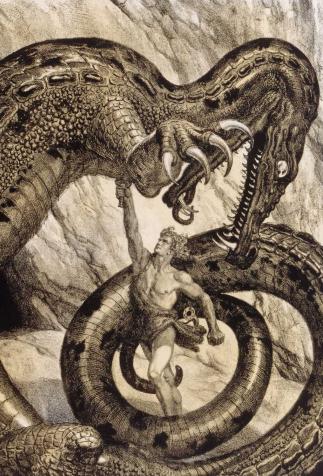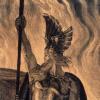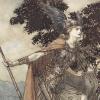The Song of the Nibelungs: Metamorphosis of a Saga
Originating in Germany, The Song of the Nibelungs resonated throughout medieval literature. A ubiquity that has provided contemporary fantasy with several now-classic tales.
A Medieval Classic
The Song of the Nibelungs (“Nibelungenlied” in German) is a German poetry cycle written in the late twelfth and early thirteenth centuries whose author is unknown. It tells the story of the hero Siegfried, of his he dies, and how his wife, Kriemhild, seeks vengeance, leading to the fall of the Germanic Burgundians. Although the work is often described as a Germanic epic poem, the tone is sometimes seen as more dramatic than epic.
The Song of the Nibelungs as we know it is believed to be a rewriting of an earlier, twelfth-century version, of which there are no known extant copies. The story must have been fairly popular in the Middle Ages, because nearly three dozen manuscripts written in the thirteenth and fourteenth centuries have come down to us.
As with the Sagas, the question of the text’s historical value is a legitimate one, because although several of the characters and families mentioned really existed, they were not all alive at the same time. What’s more, although there are not many magical elements in the text compared to the Scandinavian versions, the story does combine history and the supernatural, making one wonder about the text’s legendary aspect.
A Tale with Many Sources
Equivalents to The Song of the Nibelungs can be found in several Icelandic texts, including the two Eddur, which respectively provide a prose and a poetic version, as well as certain sagas, like the Völsunga Saga (thirteenth century), a so-called legendary saga, and the Þiðrekssaga (or Thidreksaga, thirteenth century), a knights’ saga. While those various texts are basically quite similar, there are some notable differences. The status of the hero, Sigurd in Old Norse and Siegfried, in German, as a youth varies from princely (Völsunga Saga, Prose Edda, Poetic Edda), to a child raised by a doe (Þiðrekssaga), via hybrid cases in which he is a prince, but sometimes described as a wandering warrior (Song of the Nibelungs).
Similarly, the dragon’s death and the powers the hero acquires may also be different. It may include the ability to understand birds (the Völsunga Saga, Prose Edda, particularly the poem Fafnismal) or to acquire skin as tough as an animal’s horns (Þiðrekssaga, Song of the Nibelungs). Finally, depending on the versions, he dies either in bed (Völsunga Saga, Prose Edda) or while on a hunting party in the woods (Þiðrekssaga, Song of the Nibelungs, Poetic Edda).
So the sources may vary widely, making it difficult to establish a precise genealogy of the texts. The Song of the Nibelungs’ popularity over the centuries is based on rapprochements between the various interpretations. Both the Brothers Grimm’s version and Richard Wagner’s have contributed greatly to intertwining them.
The Song of the Nibelungs Today
There have been many reinterpretations of the tale on film, too, since Mario Caserni’s Siegfried (1912) and Fritz Lang’s two-part The Nibelungen (1924). It has also been the inspiration for several comic strips and manga, such as Leiji Matsumoto’s Harlock Saga: Der Ring des Nibelungen (1992-1999) and Alex Alice’s Siegfried (2007-2011), and even cartoons, like the TV version of the manga Saint Seiya (1986-2008), which adds a plot line about Odin’s warriors that is not found in the print version. Video games also propose hybrids of the genre, such as the science-fiction word of the game Ring: The Legend of the Nibelungen (Cryo Interactive, 1999).







